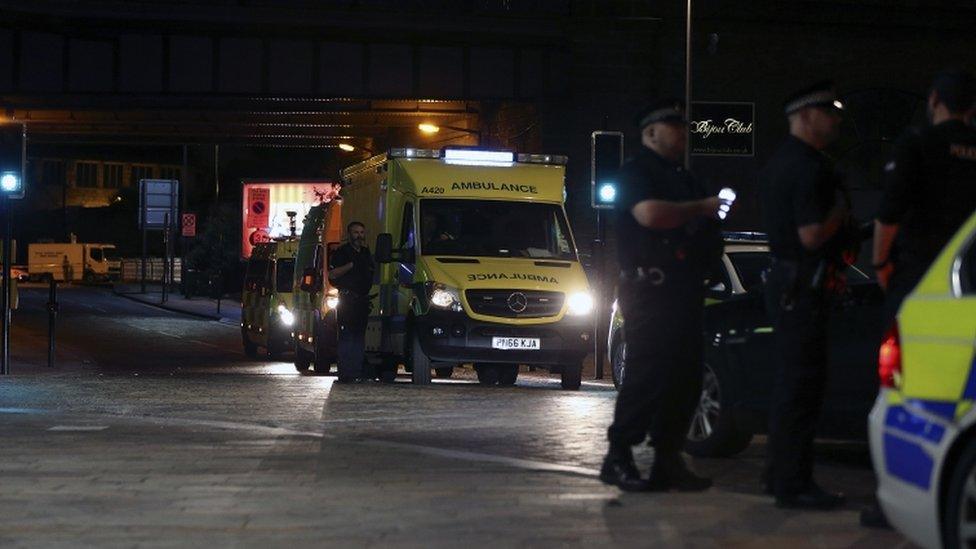How do terrorism threat levels work?
- Published

The terrorism threat level in Northern Ireland has been raised.
The UK's terror threat scale was first made public in August 2006, a year after the London Tube and bus bombings that killed 52 people.
A separate threat level for Northern Ireland was introduced in 2019.
What are the threat levels?
There are five levels, external:
critical: an attack is expected imminently
severe: an attack is highly likely
substantial: an attack is a strong possibility
moderate: an attack is possible, but not likely
low: an attack is unlikely
How have they changed?
The UK threat level was first raised to "critical" on 10 August 2006, just nine days after the scale was published, following the discovery of a plot to blow up as many as 10 planes flying from Britain to the US.
It was also raised to "critical" following the car attack on Glasgow Airport on 30 June 2007, in which the only fatality was one of the assailants.
And it was put at "critical" on 23 May 2017, the day after the Manchester Arena suicide bombing, and remained there until 27 May, when it lowered to "severe".
The threat level was also briefly raised to "critical" on 15 September 2017 following the Parsons Green attack on the London Underground.
In July 2019, the main terror alert system was changed to include all forms of terror threats "irrespective of the ideology that drives them".
Until this point, the scale only took into account the risks posed by "international terrorism" - but was updated to reflect threats from right-wing, left-wing and Northern Irish groups.
On 4 November 2019, the threat level was downgraded to "substantial".

The threat level was raised following the Manchester Arena attack, which left 22 people dead
On 3 November 2020, the level was again raised to "severe", described by then-Home Secretary Priti Patel as "a precautionary measure" following attacks in France and Austria.
On 4 February 2021, it was reduced to "substantial" before returning to "severe" in November 2021.
It was again reduced to "substantial" on 9 February 2022, where it remains.
How does the Northern Ireland level work?
In September 2010, additional scales were introduced to rate the threat level from terrorism related to Northern Ireland.
As part of the changes to the system in 2019, these were reduced to one separate level for Northern Ireland itself.
When it was first introduced on 23 July 2019, the risk was assessed to be "severe", before being reduced to "substantial" on 22 March 2022.

Detective Chief Inspector John Caldwell was shot multiple times in Omagh, County Tyrone
On 28 March 2023 the threat level was again increased to "severe". The move followed a rise in dissident republican activity, including a gun attack on a senior police officer in February.
Who decides threat levels?
The threat level for the UK from international terrorism is set by the Joint Terrorism Analysis Centre (JTAC), external, an organisation made up of representatives from 16 government departments and agencies. The head of JTAC reports to the director general of MI5.
MI5 sets the threat level for Northern Ireland.
The security service says the threat level decisions take into account a number of factors including:
available intelligence - sometimes "specific threat information" but often relying on a wide range of information
terrorist capability, irrespective of ideology - including analysis of the potential scale of an attack
terrorist intention - including assessment of particular targets
timescale - the likelihood of an attack in the near term
How should the public respond to changing threat levels?
The government says updated threat levels in themselves do not require specific responses from the public.
It says the levels are "a tool for security practitioners working across different sectors of the Critical National Infrastructure (CNI) and the police to use" when deciding which protective security measures may be required.
The MI5 website says: "Vigilance is vital regardless of the current national threat level," and that "sharing national threat levels with the general public keeps everyone informed".
It adds that making the threat level public "also helps explain the context for the various security measures (for example airport security or bag searches) which we may encounter in our daily lives".
The website urges members of the public with information about possible terrorist activity to call the Anti-Terrorist Hotline on 0800 789 321.
For warnings about possible bombs or other urgent threats, people are asked to call 999.